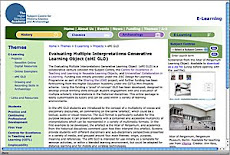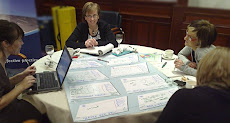Many of the RLOs we develop for the CETL are interactive tutorials. New material is presented as text, audio, graphics and video in a series of screens. Text is probably the most used media element in our projects.
Reading lots of text can become tedious for the learner and it makes them turn off, get distracted and only partially engage with the content. In this post, I look at how you can sharpen up your writing to make easier for your learners to understand new content, reflect on it, remember and practice it.
First some facts about how learners read text online:
They read much more slowly online than reading from a book or article.
They find on-screen text harder to read than paper based text.
They often scan on-screen text rather than studying it.
They read screens in an F shape – across, down, across, down.
So, how can you write text that is readable, engaging and that also gets your content message across? Here are some tips that you can try out on any new productions. Like all new skills, you will need to practice a lot before it becomes second nature.
My tips on writing text:
If you are an academic, you are probably used to writing a specified number of words for a thesis, article or book. This doesn’t apply in e-learning, where you should try to write as few words as possible to get your message across.
1) Keep your sentences short and declarative.
2) Limit punctuation to full stops and commas – this will help you stop writing long, complex sentences.
3) Avoid using passive sentences and write actively. Here’s a passive sentence: “the mixture is placed in a beaker, and the temperature is then raised.” Here’s the same information written actively: “you put the mixture in a beaker and heat it up.” This is particularly important if you are thinking of recording your text as audio – passive sentences will sound stilted.
4) Simplify your vocabulary as much as possible. Use ‘so' instead of ‘therefore', ‘but’ instead of ‘however’, ‘goes before’ instead of ‘precedes’.
5) If your subject requires you to present long text pieces, consider offering them as downloadable pdfs – your learners will appreciate ‘take away’ texts.
6) When you have finished writing a piece of text, edit it to use fewer words without losing the content message. Try to use 50% fewer words – you won’t always be able to do it, but the effort will make your text sharper in your current and future productions.
Some tips on presenting text:
You don’t always have to present text as sentences in paragraphs. Consider presenting it in these ways:
Use headings to help anchor learners to the topic, remember learners will scan your pages
Use bulleted lists
Use clickable bulleted lists - click to reveal more content – it makes information easier to read and assimilate
Use tables
If you need any help, please contact me.
Rob Alton
Friday 19 December 2008
Subscribe to:
Post Comments (Atom)





No comments:
Post a Comment